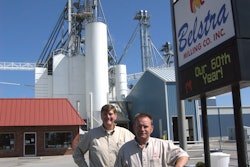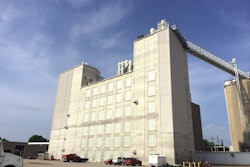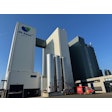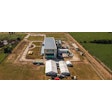With its sights set on positioning the cooperative as the fastest, most efficient by-products shipper in the Pacific Northwest, Ag Processing Inc (AGP) began loading ocean-bound vessels filled with soy meal and DDGS from its new port terminal elevator at the Port of Grays Harbor (PGH) in January 2012.
According to AGP's senior director of exports Chris Schaffer, who oversees the co-op's export trading operations in the United States, the heightened demand for agricultural products out of Asia, China in particular, drove PGH and AGP to make the $60 million investment in the expansion. Schaffer, who first joined AGP in 1994, spent a brief stint at the U.S. Grain Council (USGC) as the manager of operations for Asian markets from 1999 to 2001. During this time Schaffer established relationships with Asian customers and focused on educating off-shore customers about GMOs and biotechnology. In 2001, he decided to return to trading, bringing his knowledge of export demand to AGP.
“The leadership of AGP saw a vision that there was a good export opportunity off of the Pacific Northwest for AGP processed products, mainly being soybean meal, and saw that Asian markets were demanding more U.S. soy products,” says Schaffer, pointing to the burgeoning populations in Southeast Asian countries and poultry consumption which requires the meal for poultry feed. According to Schaffer, the increase in meat consumption in China resulted in the country expanding its soybean crushing capacity, thereby spiking the demand for whole grain soybeans increased.
As demand shifted abroad, PGH was also reasonable proximity to AGP’s soybean processing assets by rail and freight rates were lower. In 2004, AGP built a rail-to-ship unloading facility at the Port of Gray’s Harbor in Terminal 2. This model worked well for while, but as the global appetite for proteins grew, the site needed to add storage and the ability to move and grade whole grain for export. In 2012, the company completed the expansion of its existing operations with the addition eight 350,000-bushel storage silos — moving the port terminal from strictly loading processed products (soy meal and DDGS) to also moving and storing grain for export from its member owners.
2012 Trends
Referencing the crisis in the eastern corn belt and the dry temperatures in the western corn belt, AGP’s membership and processing plants are in the West so it maybe in a better position with a problem crop.
“We see great demand in the Asian market going forward in 2012/13 crop year,” Schaffer says. The biggest issue facing is the challenge we’re having with U.S. weather,” he says. “We may have a problem maintaining the amount off the PNW as we’ve done in the past year.”
In 2012, Schaffer predicts AGP-Port of Grays Habor will load 25 to 35 vessels with soy meal, soybeans and DDGS from AGP processors and its member owners; the port will move 1 to 2 million tons of by-product to export markets across the Pacific.
About
AGP (www.agp.com), the largest farmer-owned soybean processor in the world, is owned by local and regional cooperatives representing over 200,000 farmers from 16 states throughout the United States.
The Port of Grays Harbor, Washington State’s only deepwater port on the Pacific Coast, is only 1.5 vessel hours from open sea. More information and photographs of the marine terminal site are available on their website at portofgraysharbor.com.















